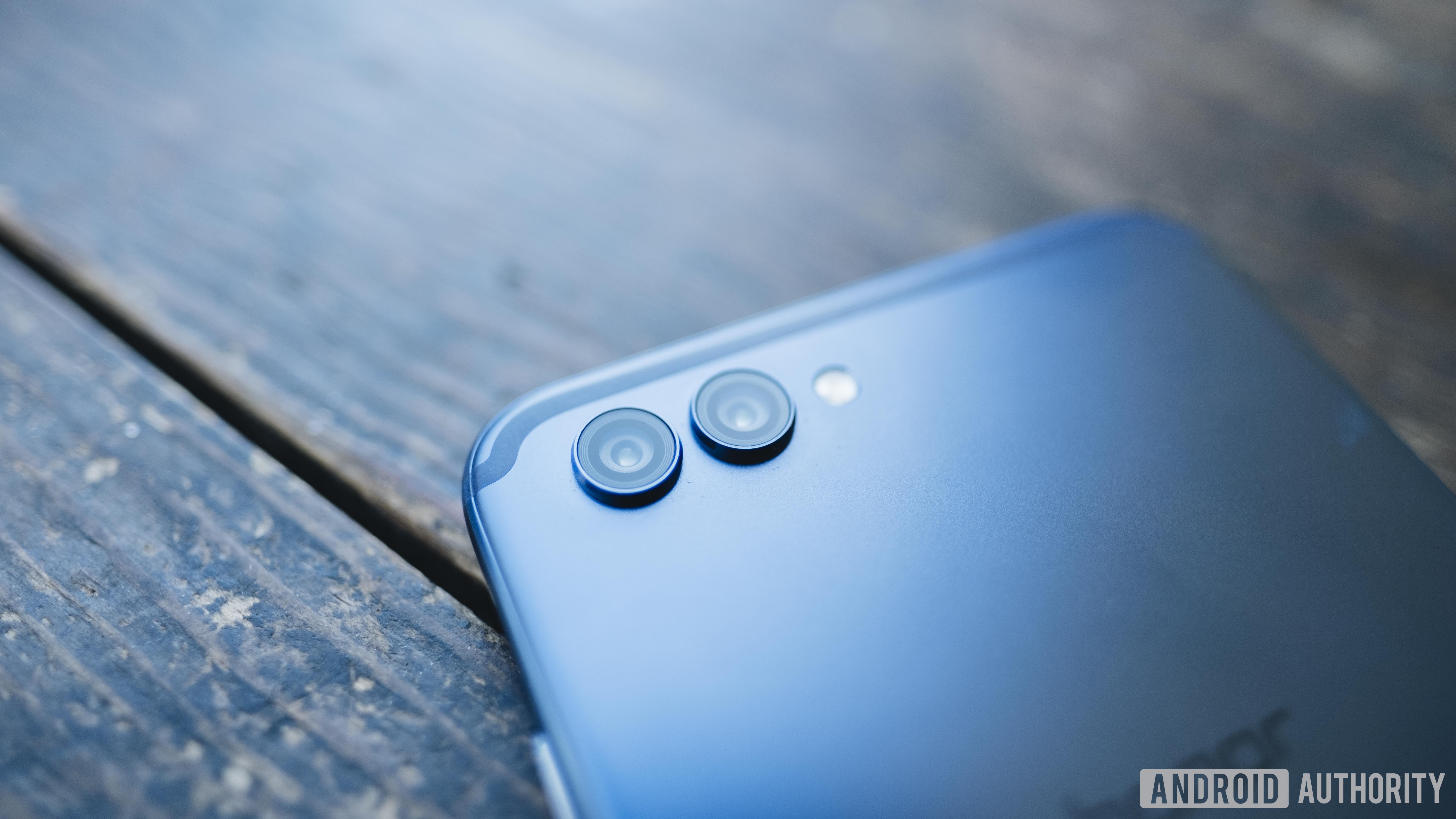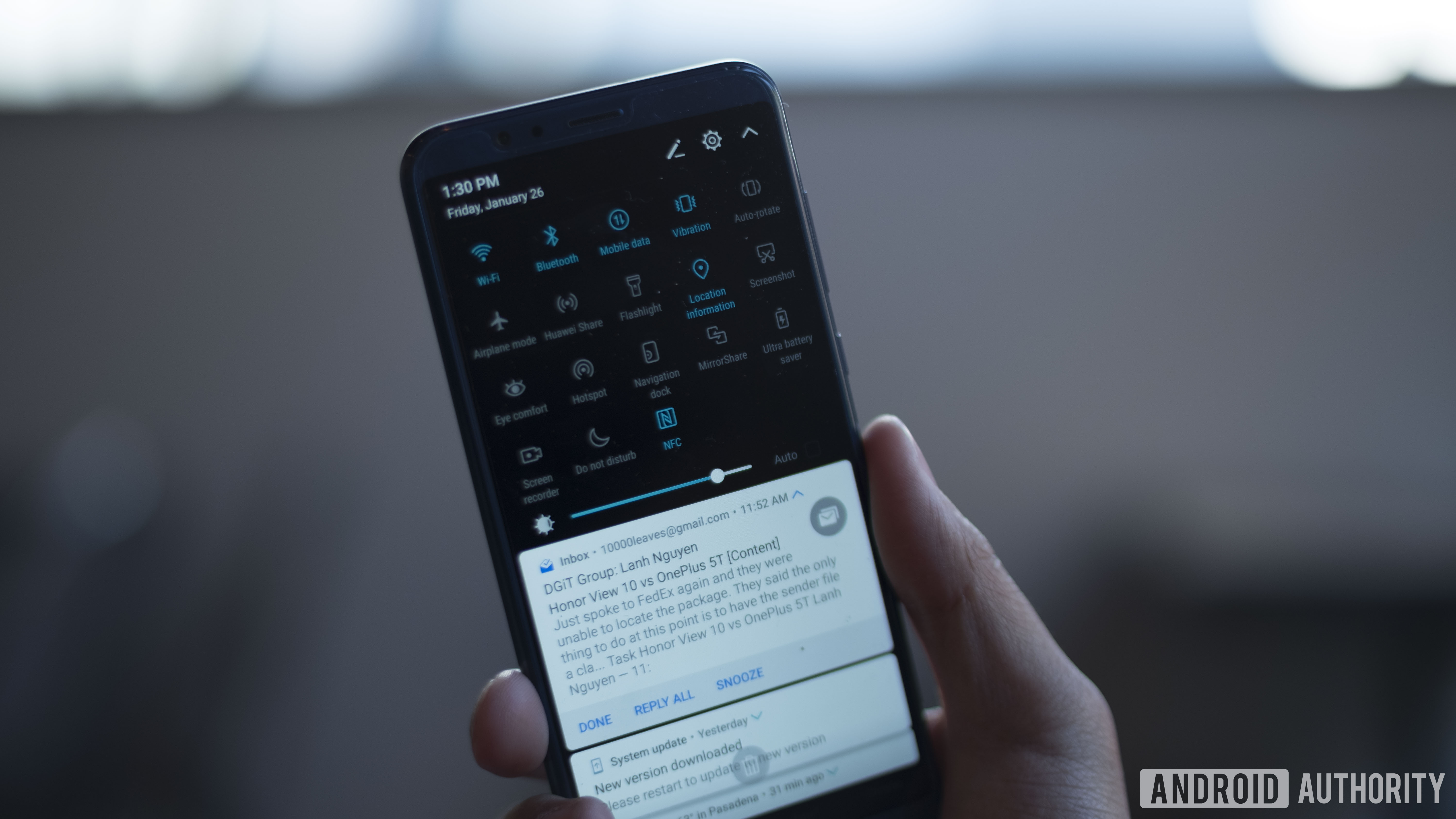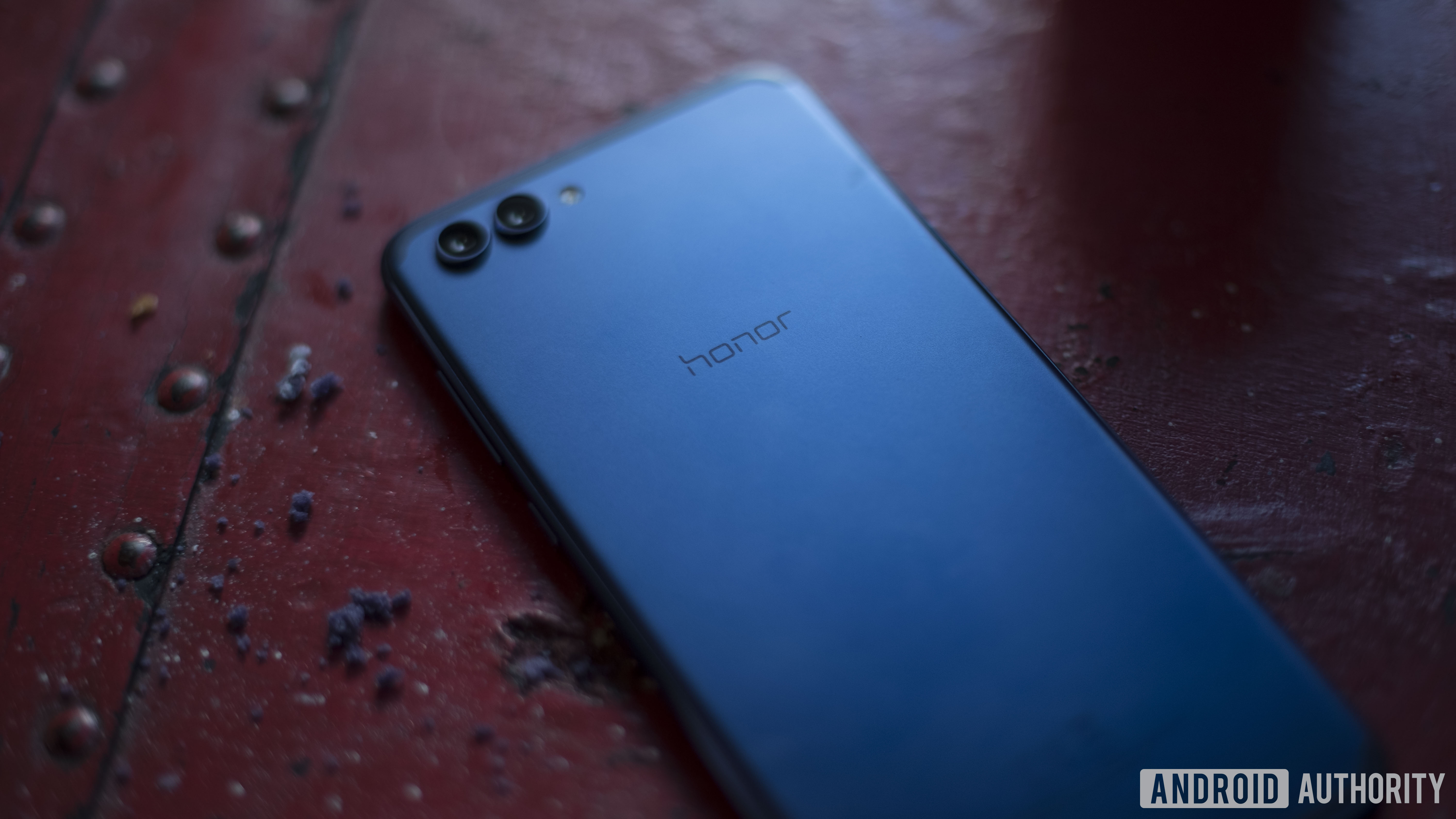The flagship space is saturated with contenders on all sides and typically they come at a high price. Companies like OnePlus have been trying to shake things up by making their flagships at least somewhat affordable, and users have been clamoring for more offerings that tick more boxes than most mid-range devices, while still maintaining their mid-range price point. Honor has been trying to find that balance, from its Honor 7X — an impressive offering for under $200 — to its latest flagship offering, the Honor View 10 (aka V10).
The Honor View 10 rivals that of the OnePlus 5T in its spec sheet and design, while bringing some Eastern flair to the software — and all for less than $500. This is the Honor View 10 review.
Design

Called the V10 in other markets, the View 10 looks quite nice. Our unit has a dark blue metallic tint which shines brightly on the front around the screen and has a more softly reflective matte finish on the back. The corners and sides are rather rounded and the phone is just thick enough to allow room for the headphone jack on the bottom.
Other colors are available but this dark blue is great: understated on first glance and then striking. The spartan backing, with just the Honor logo in the middle and dual camera setup in the corner, where both lenses individually pop out, is especially nice. Yes, that might mean the lens is in danger of scrapes and scratches, but it certainly gives the Honor View 10 a distinct look.

Despite having a 5.99-inch screen, the phone's handling is helped by its taller 18:9 aspect ratio. The result is a phone with a low screen-to-body ratio and a great looking front broken up by only a couple of features. Up top are the usual sensors and so on, but beneath the screen is a capacitive home button with an embedded fingerprint reader. That capacitive button can have multiple functions via gesture controls.
The capacitive fingerprint reader lets you navigate via gesture controls
A navigation setting allows for taps and swipes to trigger what would otherwise be the soft keys — back, home, and recent apps. This frees up the screen for more work and play. After getting used to the trigger for Google Assistant — swipe up from anywhere underneath the screen — this One Button mode became second nature. Even if it adds to the overall footprint of the phone, the single capacitive key is very useful.

Display
18:9 aspect ratios are hardly unique anymore, but it is nice to see Univisium coming to more phones than just high-end flagships. Much like the OnePlus 5T, this screen is kept at Full HD+ resolution. It's an IPS panel which does get bright enough for outdoor viewing, though I do wish it got just a little bit brighter. Colors are also where they should be, with Honor's tuning providing saturation on par with other high-performing IPS panels, though it does not reach the same levels of OLED vividness.

Text and media all look fine on this screen, but I had to go into the settings and shrink down the rendering sizes. Elements provided by EMUI seem created for a 1080p screen, but not necessarily one this big. This is more of a software peeve than a knock against the screen. It was easily fixed — bringing down the setting by one notch made everything look proper and not bloated.
If there is one thing missing here, it is an always-on display. Plenty of manufacturers have been including this to make seeing one's notifications easier and I wish the View 10 had it too. It's got an LCD panel, meaning it would consume more battery than on an OLED screen, but the feature still would have been useful.
Performance
Honor spared little expense making sure this phone has top-notch performance. Though it's only just starting to happen in the West, it's pretty normal in Asian markets to have over 4 GB of RAM and a high amount of storage. The View 10 comes with 128 GB of storage and 6 GB of RAM. No matter how you cut it, that is great to have on a phone at this price.
Honor spared little expense making sure this phone has top-notch performance: the View 10 comes with 128 GB of storage, 6 GB of RAM and the Kirin 970

Honor takes the specs sheet a step further by putting in the latest Huawei HiSilicon processor, the Kirin 970. Yes, the one with the Neural Processing Unit (NPU). The true benefits of neural processing are yet to be proven — this is the first time consumers are seeing this kind of chipset, after all, and its applications are still rather limited — but this is a feature which should be better utilized over time.
For now, the NPU works in the camera for automatically finding the right scene mode and for optimizing memory handling based on your usage habits, but there is little else differentiating this phone's performance from other flagship devices. To that end, the Kirin 970 still does its core job well in providing reliable, smooth, and fast performance.
Hardware
The View 10's feature set reflects its design and also sticks to the basics. A microSD card slot can increase the already high amount of built-in storage, and all the connections you'd expect are available. It even has NFC for contactless payment platforms. There is no IP certification on this phone, however, so users will have to be a bit more careful to keep everything dust-free and dry.

Though calls were just fine on the T-Mobile network, using this European version of the phone kept me on HSPA+ and Wi-Fi most of the time. That means my battery experience wasn't quite indicative of what users might get on mostly LTE connectivity.
The 3,750 mAh battery got me through a day start to finish without any problems
Nonetheless, the phone's 3,750 mAh battery got me through a day start to finish without any problems. Screen-on time, in particular, got up to six hours while I was mainly on Wi-Fi playing mobile games and watching YouTube. With fast charging solutions, it doesn't take long for the phone to get back to 50 percent, either. You will be relying on a USB Type-C charger, however, as wireless charging is not included in this metal-clad device.
Speaking of YouTube, I have to give a nod to the onboard speaker. It is easy to scoff at a bottom-facing mono speaker unit, but I was surprised to hear some decently loud and rich audio. Being able to put a pair of headphones in easily, thanks to the headphone jack, was also appreciated.

Camera
On an affordable flagship phone, cameras tend to be the make-or-break feature on an otherwise great package. The camera of the View 10 puts its best foot forward with a dual lens system much like the one found on the OnePlus 5T. The phone's rear features a 16 MP f/1.8 aperture shooter, with a monochrome 20 MP f/1.8 secondary sensor for adding detail to color photos or taking crisp B&W shots. Together with the potential power of the NPU, this combined camera package can yield some sharp and enjoyable photos, except when using the 13 MP front-facing camera.

I hesitate to say the front-facing camera is all that bad, because it is really just down to Honor's tuning of the software. The View 10 clearly takes a lot of cues from its original Chinese market, where most front-facing cameras focus on beauty modes and tend to be very soft. The camera tends to overexpose for a brighter photo and still yields an overly soft selfie even when all the modes are off.
The beautification mode is also available with background bokeh effects — turn them on and things get even softer than before, and my freckles simply disappear. If you want to keep your facial features intact but maintain a soft background, the Wide Aperture mode allows for similar effects but the results can be spotty. This beauty mode might be great for someone who appreciates the airbrushed look, but that person is not me. The best I can say is that the front-facing camera is certainly capable of good photos, but what that actually means to each individual user could differ.
- Normal
- Wide Aperture
- Beauty Mode
Portrait mode and wide aperture modes are available for the rear cameras as well, and when used with some extra care, the photos coming out of the phone can be pretty great. Sharpness is where it should be — essentially the opposite of the front-facing camera — and colors are mostly accurate. The camera tends to overexpose when tapping darker areas, but a bit of work on the compensation slider will make the photo look more accurately exposed. As I said, with a little bit of extra attention to detail, the View 10's cameras do their job pretty well.

There are plenty of other modes included in this camera package, like HDR, which is a mode rather than a toggle (a personal pet peeve). There are also pro modes and more artsy modes if you want to get fancy. I also like that the video mode has the ability to use the Wide Aperture setting while recording. It can lead to some interesting — albeit very artificial — depth of field footage. However, the camera is already pretty wide at f/1.8, so bokeh is not hard to come by.

Unfortunately, you will need very steady hands because there is no OIS on the View 10. This is a problem immediately apparent in video recordings, but it also hinders the phone's low light performance. A prompt for the user to "hold hands still" while sharpening the image reflects a long shutter due to the lack of lighting. During that time basically any movement will make the photo blurry. OIS would have been a great addition to an otherwise quite capable dual lens setup, but affordability often creates that kind of give-and-take situation.
You will need very steady hands because there is no OIS on the View 10 camera
Software
The software experience differs from many established UIs in the West. Honor is a company from the East, after all, and it brings with it some of the common tropes found in Chinese spins on Android. It lacks an app drawer by default, but you can change the "Home Style" in the settings or just get a new launcher altogether.
Unlike some phones released in Asia that we've imported for review, this Honor View 10 is made for Europe, so all the textual elements fit properly in the interface.
Dive deeper into the settings menu and you'll find a ton of different ways to customize the experience too. We already mentioned the navigation dock earlier, where the one capacitive key can be used for anything that the soft keys would otherwise do. Aside from that are some app-centric abilities, like putting access to some apps behind a lock or making more than one instance of, for example, a social media application.

Speaking of social media, a nice feature in the gallery app allows for one-click sharing of photos straight to Snapchat. This is more useful for people who are on that network, but it can be handy and it eliminates having to use the often shoddy built-in Snapchat camera.
Finally there is Face Unlock, which is basically what it sounds like — after recognizing the user's face, the phone will unlock and go straight into the home screen quickly. It works about as good as similar features found on other phones, but Honor added a couple other functions into the mix. One ability shows sensitive information in notifications on the lock screen only when recognition is achieved. The phone can also wake when raised, which makes for a fast unlocking experience when coupled with Face Unlock.

Overall, there are some good features added to this version of Android and launching with Android 8.0 Oreo is a big plus, too. EMUI has its fans but it also has some detractors, so if you've had contact with any other Huawei or Honor phones recently, you'll already know how you feel about it.
Specs
| Honor View 10 | |
|---|---|
| Display | 5.99-inch IPS 1080 x 2160 resolution 403 ppi 18:9 aspect ratio ~78% screen-to-body |
| Processor | HiSilicon Kirin 970 |
| GPU | Mali-G72 MP12 |
| RAM | 4/6 GB |
| Storage | 64/128 GB microSD card expansion up to 256 GB |
| Cameras | Rear cameras Main sensor: 16 MP RGB, f/1.8 aperture Secondary sensor: 20 MP monochrome, f/1.8 aperture Front camera: 13 MP, f/2.0 aperture |
| Audio | Bottom-facing speaker |
| Sensors | Fingerprint Hall Accelerometer G-sensor Electronic compass Gyroscope Proximity Ambient light |
| Battery | 3,750 mAh |
| Material | Metal unibody |
| IP rating | None |
| Networks | GSM, HSPA, LTE |
| Connectivity | Wi-Fi: 802.11 a/b/g/n/ac, dual-band, Wi-Fi Direct, hotspot Bluetooth 4.2 with aptX HD GPS NFC Infrared |
| Ports | USB Type-C 3.5 mm audio jack |
| SIM | Dual Nano-SIM |
| Software | Android 8.0 Oreo EMUI |
| Colors | Navy Blue, Midnight Black, Beach Gold, Aurora Blue, Charm Red |
| Dimensions and weight | 157 x 75 x 7 mm 172 g |
Gallery
Pricing and final thoughts
The Honor View 10 price tells a good story. Any phone with features like this that comes in under $500 is going to pique our interest. Though there are even cheaper phones available and certainly higher-powered phones (at higher prices too), this phone's market segment includes pretty much just the OnePlus 5T.

We will do a comparison between the two soon, but the bottom line is this: Honor has done a great job delivering a high-end experience at a mid-range price, and with potential improvements to the Kirin 970's NPU still to come, the View 10 could maintain relevance longer than even some big ticket flagships. The Honor View 10 is done very well, and at this price point the whole package puts up a very convincing argument for anyone in the market for a OnePlus 5T.
from Android Authority http://ift.tt/2DWNtcR
via IFTTT





































































No comments:
Post a Comment